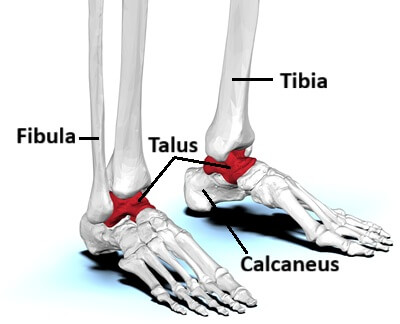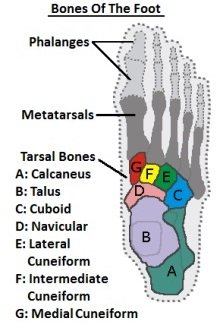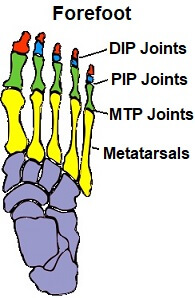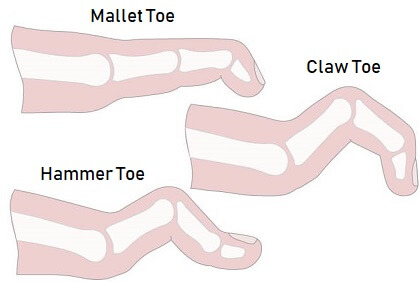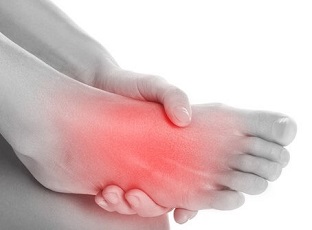- Home
- Anatomy Guide
- Bones
Foot Bones: Anatomy, Function & Common Problems
Written By: Chloe Wilson BSc(Hons) Physiotherapy
Reviewed By: FPE Medical Review Board
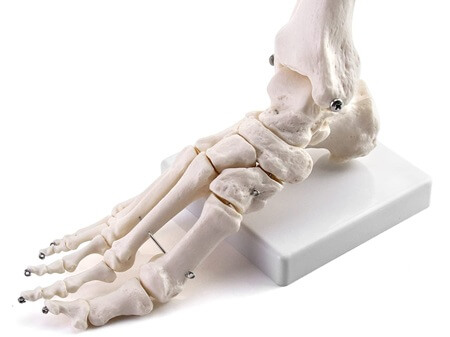
There are thirty foot bones in humans making the foot and ankle a complex structure.
These foot bones work together to absorb shock, support body weight, maintain balance and make every step efficient, no small task when you consider we take around 10,000 steps a day.
The most common problems affecting the foot and ankle bones are fractures, abnormal positioning e.g. flat feet, and excessive bone growth e.g. bunions and bone spurs
In this guide, I’ll take you through every bone in the foot and ankle, how they fit together, what they do, and the most common problems that affect them.
How Many Bones Are in
the Foot?
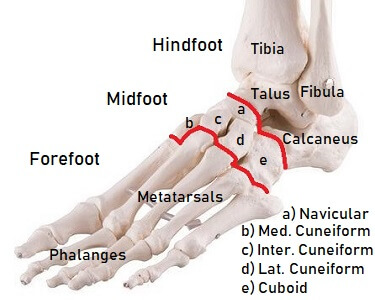
Each foot contains 28 standard bones and 2 sesamoid bones. Some people also have extra accessory bones.
The foot can be divided into three main sections:
- Hindfoot: back of the foot
- Midfoot: middle of the foot forming the arches
- Forefoot: front of the foot, including toes
Similarly, the bones can be grouped into four main groups:
- Leg Bones (2): tibia and fibula
- Tarsal bones (7): hindfoot + midfoot
- Metatarsals (5): long bones of the forefoot
- Phalanges (14): toe bones
- Sesamoid bones (2): tiny bones under the big toe
Common issues affecting foot bones include fractures, abnormal positioning e.g. flat feet, and excessive bone growth e.g. bunions, bone spurs.
Let’s have a look at the different parts of the foot in more detail.
1. Hindfoot Bones
The hindfoot is the back section of the foot and includes four bones: the tibia, fibula, talus and calcaneus.
These form the ankle joint and the subtalar joint, allowing up-down and side-to-side movement.
Tibia
The tibia is the larger shin bone and forms the top and inner side of the ankle joint where it meets the talus. The bottom end of the tibia widens to create the medial malleolus, the bony bump on the inside of your ankle.
Fibula
The fibula is the slender bone running down the outside of the lower leg. It forms the lateral malleolus, the bony lump on the outer ankle, which sits slightly lower than the medial malleolus.
Together, the tibia and fibula form a socket for the talus. It provides ankle stability rather than weight-bearing strength.
Talus
The talus is the highest bone in the foot, sitting between the shin bones and the heel bone. It forms the:
- Ankle Joint: with tibia and fibula. Allows the up and down motion of the ankle
- Subtalar Joint: with the calcaneus. Allows side to side movement
Interestingly, no muscles attach to the talus - it is held in place entirely by its shape and strong ligaments.
Calcaneus
The calcaneus, or heel bone, is the largest foot bone. It bears much of the body’s weight during standing and walking. The Achilles tendon attaches at the back of the calcaneus, connecting the calf muscles to the heel. It’s also the most commonly fractured tarsal bone, usually from a high fall.
2. Midfoot Bones
The midfoot contains five tarsal bones that form the arches of the foot. They are crucial for shock absorption. The bones in the midfoot are:
Navicular
Located on the inner side of the foot, the navicular links the talus to the cuneiform bones and also articulates with the cuboid.
Around 10% of people have an accessory navicular, a small extra bone that can cause inner arch pain.
Cuboid
The cuboid sits on the outer side of the midfoot and connects the heel bone to the fourth and fifth metatarsals. It also links to the navicular and lateral cuneiform.
Problems here can cause cuboid syndrome, a common source of lateral foot pain.
Cuneiform Bones
There are three cuneiform bones:
- Medial Cuneiform (1st): inner side
- Intermediate Cuneiform (2nd): middle
- Lateral Cuneiform (3rd): outer side
The cuneiform bones connect the midfoot to the first three metatarsals and help form the medial longitudinal arch.
3. Forefoot Bones
The forefoot includes the five metatarsal bones, fourteen phalanges that make up the toes and two sesamoid bones.
Metatarsal Bones
The metatarsals are the long bones that run from the midfoot to the toes and are numbered 1–5 from the big toe across.
Key features:
- 1st Metatarsal: Shortest, thickest and strongest, supports push-off
- 2nd Metatarsal: Longest and most prone to stress fractures
- 5th Metatarsal: Most commonly fractured
Each metatarsal has a base, shaft and head and forms joints with the tarsal bones at the back and the toe bones at the front.
Stress fractures here are common in runners and soccer players most notably David Beckham (second metatarsal), Wayne Rooney (fourth metatarsal), Michael Owen (fifth metatarsal bone) and Kieran Gibbs (first metatarsal bone).
Fifth metatarsal fractures are the most common by far including:
Phalanges
Each toe is made of small bones called phalanges.
- Big Toe (hallux): has 2 phalanges
- Other Four Toes: have 3 phalanges each
The toe joints are called:
- MTP Joints: toe base between metatarsals and proximal phalanges (green)
- PIP Joints: middle joint between proximal and middle phalanges (blue)
- DIP Joints: tip joint between middle and distal phalanges (red)
Common problems here include hammer toe, mallet toe, claw toe and arthritis.
Sesamoid Bones
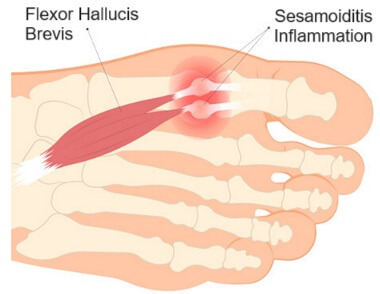
Sesamoid bones are small, oval bones embedded within tendons to reduce friction and improve leverage.
You’ll find two main sesamoid bones under the big toe joint:
- Medial (Tibial) Sesamoid
- Lateral (Fibular) Sesamoid
These sit within the flexor hallucis brevis tendon, underneath the big toe’s MTP joint, acting like tiny pulleys.
The sesamoid bones are small but really important as they:
- Absorb impact during walking and running
- Protect tendons
- Improve push-off efficiency
- Support the medial arch
Irritation of the sesamoid bones is known as sesamoiditis and is common in runners and ballet dancers.
Functions Of The Foot
Bones
Foot bones are designed to:
- Support the body’s entire weight
- Absorb shock with every step
- Keep us balanced
- Stabilise the arch
- Provide leverage for walking and running
- Adapt to uneven terrain
- Store elastic energy (like a spring) for propulsion
This incredible combination is why the foot is sometimes called a biomechanical masterpiece.
Common Problems Affecting the Foot Bones
Bone and joint problems are extremely common in the foot. Here are some of the most frequent issues I see:
- Hammer, Mallet, and Claw Toes: Toes bend abnormally due to joint misalignment
- Accessory Navicular Syndrome: Extra navicular bone causes inner arch pain
- Turf Toe: Pain and inflammation at the big toe joint, common in athletes
- Bunions: Big toe deviates inward, forming a bump on the foot’s side
- Fractures: Can be caused by trauma or repetitive stress. Most common are stress fractures and fifth metatarsal fractures
- Bone Spurs: Extra bone growth from repeated friction. Most common are heel bone spurs
- Shin Splints: Inflammation of the tibia lining, often in runners
When to Seek Medical
Advice
You should see a doctor if you have:
- Persistent or worsening foot pain
- Pain while walking or bearing weight
- Swelling that doesn’t improve
- Visible deformity
- A suspected fracture
- Sudden sharp pain after activity
Early diagnosis of foot bone problems prevents long-term issues.
FAQs About Foot Bones
1. What Are The Main
Bones Of The Foot?
1. What Are The Main Bones Of The Foot?
The foot is made up of 26 bones:
- 7 tarsal bones (hindfoot & midfoot): talus, calcaneus, navicular, three cuneiform bones and the cuboid
- 5 metatarsals (midfoot): 1st, 2nd, 3rd, 4th and 5th metatarsals
- 14 phalanges (toes): 5 proximal phalanges, 4 intermediate phalanges, 5 distal phalanges
- 2 sesamoid bones: medial and lateral sesamoid bones under the big toe
These bones create the arches and enable balance, mobility and shock absorption.
2. What Do The Sesamoid Bones In The Foot Do?
2. What Do The Sesamoid Bones In The Foot Do?
The two sesamoid bones sit within the tendon beneath the big toe. They act like pulleys, reducing pressure, improving leverage when pushing off, and helping the big toe bend smoothly during walking and running.
3. What Causes Pain In The Sesamoid Bones?
3. What Causes Pain In The Sesamoid Bones?
Pain under the big toe is often caused by sesamoiditis (inflammation), stress fractures, or overloading from running, dancing, wearing high heels, or having a high arch foot type.
4. What Is The Strongest Bone In The Foot?
4. What Is The Strongest Bone In The Foot?
The calcaneus (heel bone) is the strongest and largest bone in the foot. It absorbs most of the impact with every step, jump or landing.
5. What Is The Most Commonly Broken Bone In The Foot?
5. What Is The Most Commonly Broken Bone In The Foot?
The fifth metatarsal is the most commonly fractured foot bone. It’s vulnerable because it sticks out slightly along the outer edge of the foot and takes a lot of stress with twisting movements. Common fifth metatarsal fractures include:
6. How Many Bones Are There In Each Toe?
6. How Many Bones Are There In Each Toe?
Most toes have three bones (proximal, middle, distal phalanges).
The big toe has only two bones (proximal and distal phalanges).
7. What
Common Injuries Affect Foot Bones?
7. What Common Injuries Affect Foot Bones?
Common foot bone injuries include:
- Stress fractures (metatarsals, sesamoids, navicular)
- Acute fractures such as fifth metatarsal fractures, heel fractures, and toe fractures
- Avulsion fractures from sudden twisting
- Sesamoiditis and sesamoid stress fractures
- Midfoot sprains and Lisfranc injuries which involve both ligaments and bones
These injuries typically cause pain, swelling, bruising and difficulty weight-bearing.
8. How Can I Keep My
Foot Bones Healthy?
8. How Can I Keep My Foot Bones Healthy?
You can protect the foot bones by wearing supportive shoes, maintaining good foot alignment, doing foot strengthening and stretching exercises, avoiding repetitive overload, and seeking early treatment for pain or swelling.
Foot Bones Summary
The human foot contains 33 bones, including the tarsals, metatarsals, phalanges and sesamoid bones.
These bones form three regions, the hindfoot, midfoot and forefoot, working together to provide support, balance and efficient movement.
Common problems include fractures, bunions, toe deformities, sesamoiditis and arthritis, most of which respond well to early treatment.
You may also be interested in the following articles:
- Foot Lumps & Bumps
- Pain On Bottom Of Foot
- Causes Of Foot Swelling
- Common Foot Injuries
- Foot Pain Treatment
Related Articles
References
- Foot Bone Anatomy. Medscape
- Anatomy Of The Foot. Arthritis Foundation
- Bones Of The Foot. Teach Me Anatomy
- Foot & Ankle Anatomy. NHS Ayrshire & Arran
Page Last Updated: 17th November, 2025
Next Review Due: 17th November, 2027
